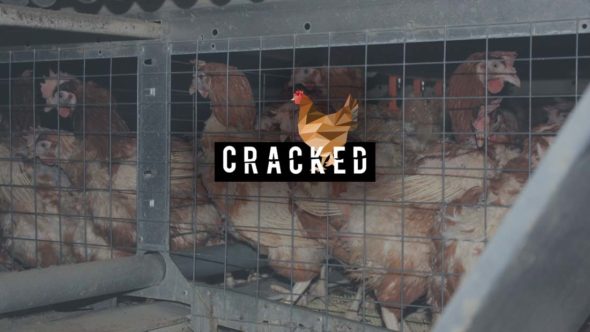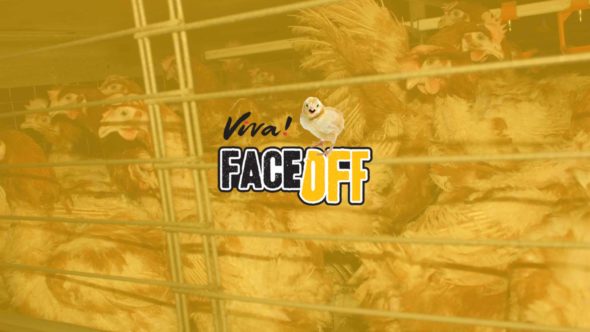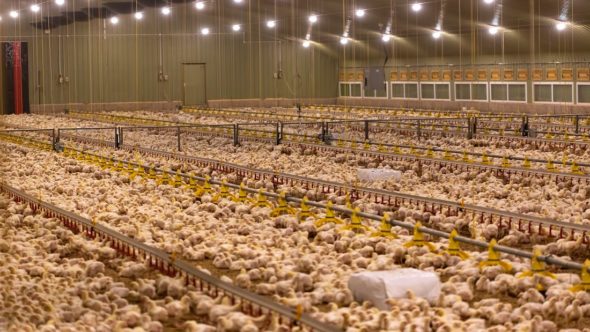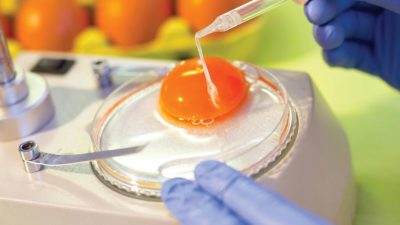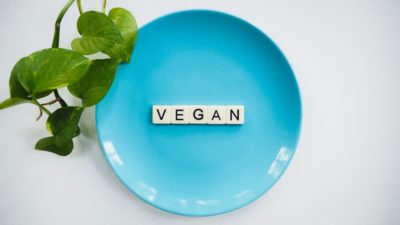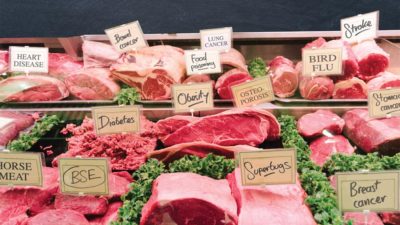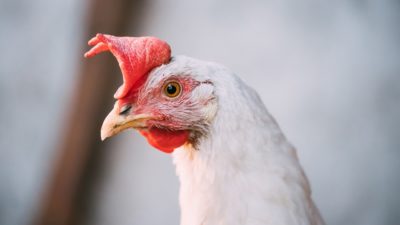How Egg-laying Hens Are Farmed and Killed

Summary
Eggs are often seen as being the least harmful, in terms of animal welfare, of all animal products. However, the amount of suffering caused to chickens in the egg industry, is at least equal to any other.
Hens may even be one of the world’s most exploited and abused animals on earth. Whether free-range or caged, they will spend the majority of their lives in dark, crowded sheds, never able to experience the freedoms of their jungle fowl ancestors.
To produce an omelette, or an egg mayo sandwich, not only means a lifetime of suffering for these sensitive, intelligent creatures, but also the horrendous suffocation of day-old male chicks.
While free-range may offer the promise of happier hens enjoying a more natural environment, this is sadly just clever marketing. The only way that you can ensure you don’t contribute to the suffering of hens and their chicks is to stop eating eggs and go vegan.
Chickens are sophisticated talkers – Chickens communicate with more than 30 vocalisations, each can be nuanced and with a distinct meaning. These calls include everything from roosters saying “I’ve found food” with an excited, rapid “tuck-tuck-tuck” to a soft, vibrating warning “errrr” that spurs little chicks to run to their mums or to flatten to the ground.1Collias NE and Collias EC. 1967. A field study of the Red Jungle Fowl in north-central India. The Condor 69(4):360-86.2Smith CL, Zielinski SL. 2014. Brainy Bird. Sci Am; 310(2):60-65.
Chickens recognise each other’s faces – Chickens recognise a large number of other chickens, not only from within their group but outsiders, too.3Bradshaw RH. 1991. Discrimination of group members by laying hens Gallus domesticus. Behav Process.143–151. 4Bradshaw RH. 1992 Conspecific discrimination and social preference in the laying hen. Appl Anim Behav Sci.33:69–75.5D’Eath RB, Stone RJ.1999.Chickens use visual cues in social discrimination: an experiment with coloured lighting. Appl Anim Behav Sci. 62:233–242. Research has shown that they can do this even when they are shown colour slides of chickens in their flock!6Bradshaw RH, Dawkins MS. Slides of conspecifics as representatives of real animals in laying hens (Gallus domesticus) Behav Process. 1993;28:165–172.
Chickens are the closest living ancestors to Tyrannosaurus rex – You might not associate the humble chicken with the most feared and famous of all of the dinosaurs, but based on molecular research scientists have discovered that chickens are closest living relative to the T-rex.7Schweitzer, MH, Asara JM, Freimark LM, Phillips M, Cantley L. 2007.Protein Sequences from Mastodon and Tyrannosaurus Rex Revealed by Mass Spectrometry. Science. Issue 5822, pp. 280-28.
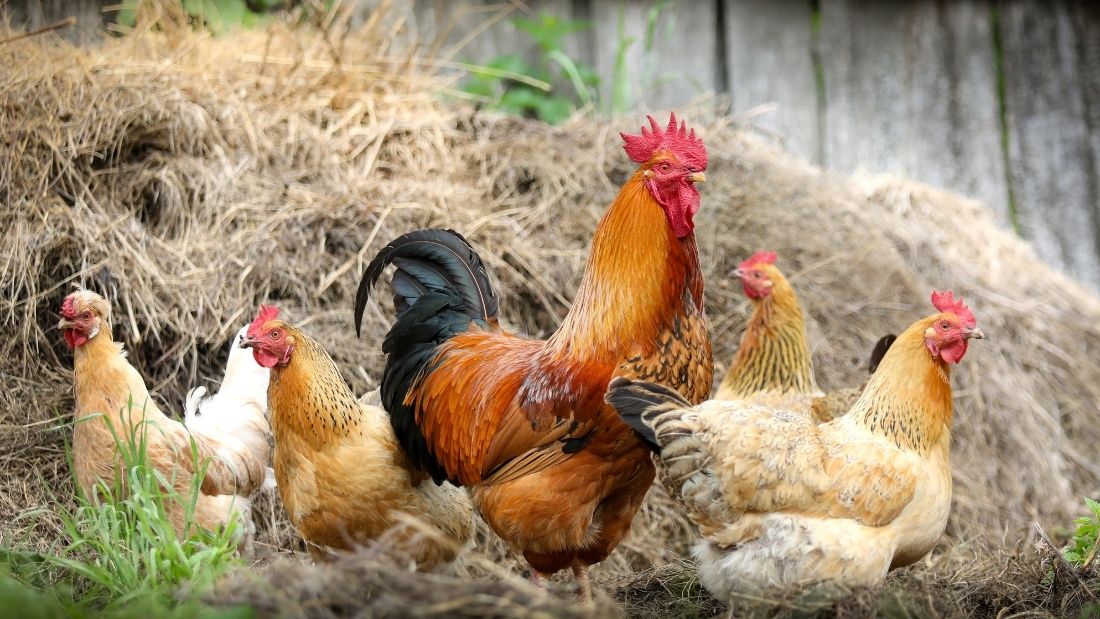
Chicks talk to their mums before they have even hatched – From embryonic stage, chicks make calls to let their mum know if they’re distressed from being cold or when they’re happy. Chick brothers and sisters communicate with each other whilst still in their eggs to synchronize hatching.8Rogers LJ. 1995. The Development of Brain and Behaviour in the Chicken CAB International 51-2.
Hens are very protective of their young – A mother hen will risk her own life to save her chicks. In the wild, if a predator detects the hen’s nest she will become raucous and draw potential predators to herself in an attempt to divert attention away from her chicks.1Collias NE and Collias EC. 1967. A field study of the Red Jungle Fowl in north-central India. The Condor 69(4):360-86.
Chickens have highly sensitive beaks – Chickens’ beaks are very important in the way that they experience the world – they use them to pick up objects, preen, nest and defend against attackers. Just like our fingertips, the tip of the beak is highly sensitive. They are filled with nerve endings for touch, pain, taste and temperature.9Gentle, MJ. J Breward J. 1986. The bill tip organ of the chicken. Agricultural and Food Research Council’s Poultry Research Centre. 79-85 10Freire R, Eastwood MA, Joyce M. 2011. Minor beak trimming in chickens leads to loss of mechanoreception and magnetoreception. J Anim Sci. 89(4): 1201-6.
Chickens can feel empathy – The ability to empathise has been associated mainly with highly intelligent species such as dolphins, great apes, elephants, pigs and dogs, but chickens can be added to that list too. Studies have shown hens displaying signs of anxiety when witnessing her chicks being distressed by a puff of air – a clear sign of a basic form of empathy.11Edgar JL, Lowe JC, Paul ES, Nicol CJ. 2011 Avian maternal response to chick distress, Royal Society, 3129-34.
Chickens have better eyesight than us – and see more colours! – Chickens have excellent eyesight, allowing them to focus close-up and far away at the same time!12Dawkins MS. 1995 How do hens view other hens—the use of lateral and binocular visual-fields in social recognition. Behaviour. 132:591. They have tetrachromatic vision, which means that chickens can see more colours than humans can, including ultraviolet light.13Ham AD, Osorio D. 2007 Colour preferences and colour vision in poultry chicks. Proc R Soc B.;274.
Chickens are as clever as monkeys! – An increasing number of studies have shown that chickens’ intelligence rivals that of dogs, primates and in some tasks, human toddlers! Chickens can count to 10,14Rugani R, Fontanari L, Simoni E, Regolin L, and Vallortigara G. 2009 Arithmetic in newborn chicks, Proc. R. Soc. B.2762451–2460. display a high level of self-control,15Abeyesinghe SM, Nicol CJ, Hartnell SJ, Wathes CM. 2011. Can domestic fowl, Gallus gallusdomesticus, show self-control? Anim Behav. 2005;70:1–11. are capable of social learning,16Johnston ANB, Burne THJ, and Rose SPR. 1998. Observational learning in day-old chicks using a one-trial passive avoidance learning paradigm. Animal Behaviour 56:1347-53. have episodic memories,17Cozzutti C, Vallortigara G. Hemispheric memories for the content and position of food caches in the domestic chick. Behav Neurosci. 2001;115:305–313. and the ability to deceive others to benefit themselves – a sign of ‘Machiavellian intelligence’.18Gyger M, Marler P. Food calling in the domestic fowl, Gallus gallus: the role of external referents and deception. Anim Behav. 1988;36(2):358–365.
Chickens outnumber humans – three to one! – There are over 23 billion chickens in the world at any one time – outnumbering humans by more than three to one. Obviously, the overwhelming majority of these are bred to produce meat or eggs for humans.19Statista.com. 2020. Number of chickens worldwide from 1990 to 2018. Available at:https://www.statista.com/statistics/263962/number-of-chickens-worldwide-since-1990/
Whether they are warning others of danger, showing off or reassuring their young, chickens are quite the chatterboxes.
Both male and female chickens can communicate with more than 30 vocalisations, each with a distinct meaning. What may just sound like random clucking to us humans is actually a variety of complex, unique signals communicating a range of messages from ‘I’m hungry’, to ‘Watch out, there’s danger!’1Collias, Nicholas Joos, Martin.1953. The spectrographic analysis of sound signals of the domestic fowl. Behaviour, 5, 175–188.2Smith CL, Zielinski SL. 2014. Brainy Bird. Sci Am; 310(2):60-65.
From the embryo
The communication between a hen and her chicks starts before they’re even hatched. Right from the embryonic stage, a developing chick, still in the egg, will emit a distress signal if he or she is too cold, prompting the mother hen to move her egg to a warmer spot in the nest.3Rogers LJ. 1995. The Development of Brain and Behaviour in the Chicken. CAB International. 51-2. Chicks respond to their mother’s attentiveness by emitting pleasure calls. As the chick forms inside the egg, they are able to hear their mother’s calls and respond. These vocalisations help birds recognise their mother after hatching.4Tschanz B.T. 1978 The emergence of the personal relationship between young bird and parents. J. Anim. Breed. Genet. Suppl. 4:51–100.
This communication isn’t just limited to hens and their chicks – chicks also communicate with each other in the nest. Clicking and bill clapping sounds made during late development help synchronise hatching, so that all of the chicks break free of their shells at approximately the same time.3Rogers LJ. 1995. The Development of Brain and Behaviour in the Chicken. CAB International. 51-2.
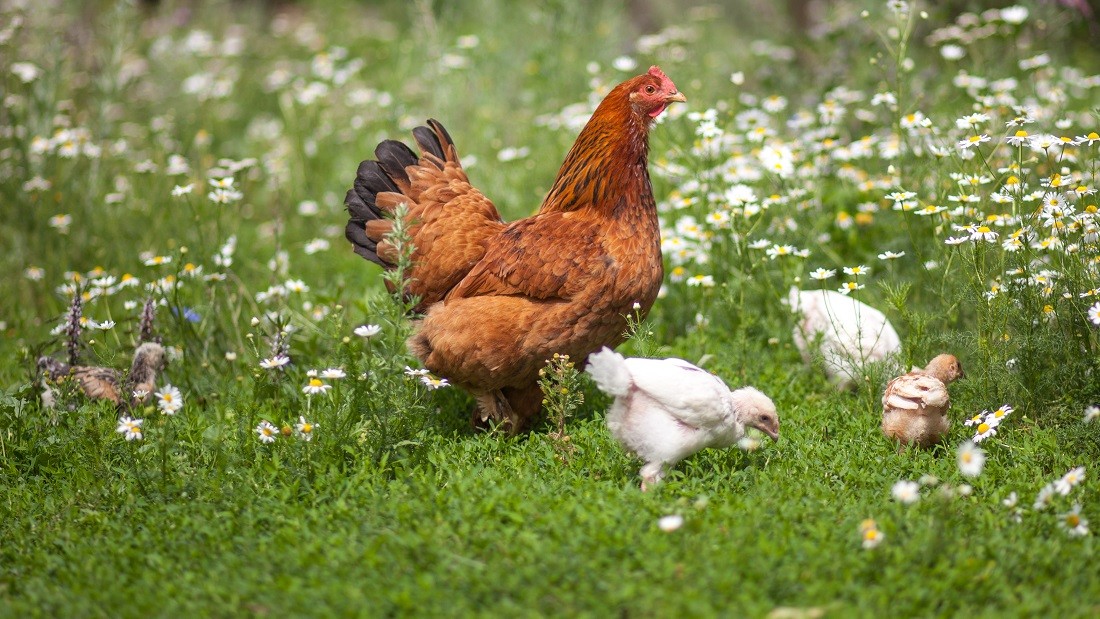
Complex signals
Chickens use referential communication (using different signals with different meanings) associated with animals of high intelligence such as dolphins, primates, domestic dogs, pigs and some birds, such as ravens.
Whilst we may hear chickens’ communication as a cacophony of clucking, when chickens talk they actually use a whole range of different signals for different purposes, such as calls, displays and whistles. They can even use these calls to confuse or deceive other birds – a sign of Machiavellian intelligence.
The type of call that chickens use is highly dependent on their intention. Males, for instance, are more likely to make an aerial alarm call when a female is present as it increases the chances of his mate and offspring surviving.5Wilson DR, Evans CS. 2008. Mating success increases alarm-calling effort in male fowl, Gallus gallus. Anim Behav. 76:2029–2035. A male chicken may choose to stay silent when there is a rival male nearby.6Kokolakis A, Smith CL, Evans CS. Aerial alarm calling by male fowl (Gallus gallus) reveals subtle new mechanisms of risk management. Anim Behaviour. Pages 1373-1380.
The type of alarm call used will also depend on the type of threat. Different calls will be used depending on if it is an aerial or ground predator and the chickens will respond appropriately to the type of danger either by taking cover, crouching down or standing alert.7Gyger M, Marler P, and Pickert R. 1987. Semantics of an Avian Alarm Call System: The Male Domestic Fowl, Gallus domesticus. Behaviour 102(1/2):15-40.
Unique voices
Chickens have their own distinctive voices. Every rooster’s crow call is unique and correlates with his comb length (the feathered crest on the top of his head) – an indicator of male dominance.8Appleby MC, Mench JA, and Hughes BO. 2004. Poultry Behaviour and Welfare. CABI Publishing p.72. Males will listen to each other’s calls to assess the dominance status of other males.9Leonard ML and Horn AG. 1995. Crowing in relation to status in roosters. Animal Behaviour 49:1283-90.
As the rooster’s call is individually distinctive, he broadcasts his identity to the whole group. When a male finds food, they combine their call with rhythmic movements involving picking up and dropping the food morsel repeatedly—a signal called the tidbitting display. Hens use these calls to decide which males will provide food and, thus, with whom they want to mate.10Evans CS, Evans L.1999 Chicken food calls are functionally referential. Animal Behaviour. 58:w307–319.11Pizzari T. 2003. Food, vigilance, and sperm: the role of male direct benefits in the evolution of female preference in a polygamous bird. Behav Ecol. 14:593–601.
This selectivity about how and when to use certain calls suggests that chicken communication is shaped by social awareness, and the ability to ‘think before they act’. Years of research has only just begun to show how complex chicken communication is. What is clear is that chickens’ communication skills provide evidence of similarity with other highly intelligent complex social species, including primates.12Nicol C. 2006. How animals learn from each other. Applied Animal Behaviour Science 100:58-63.
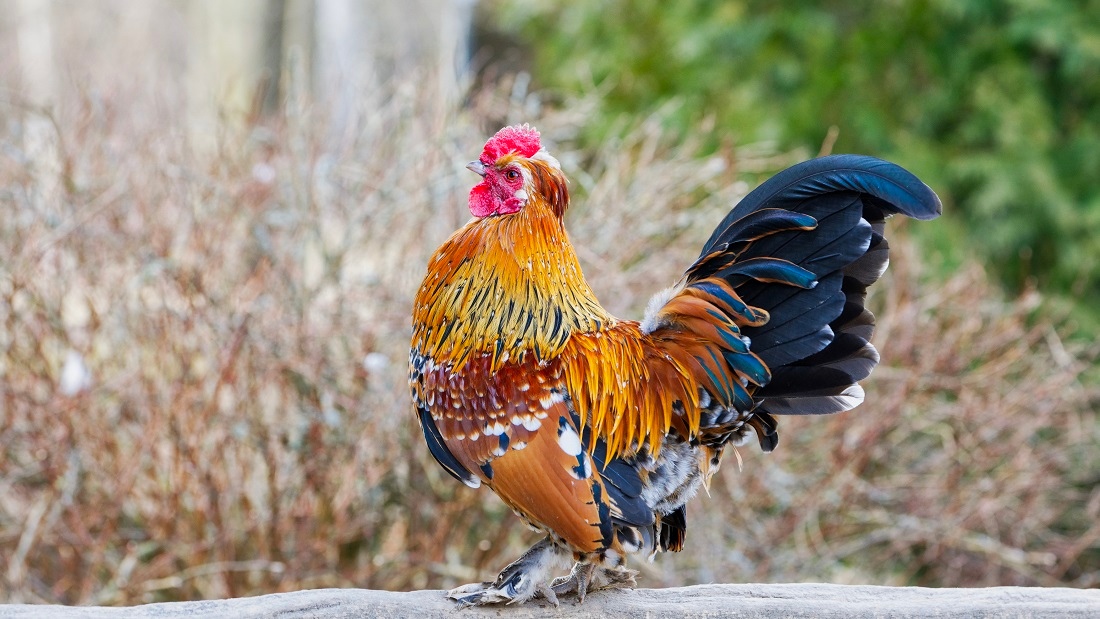
Where do chickens descend from?
The domestic chicken (Gallus gallusdomesticus) is a subspecies of the red junglefowl (Gallus gallus) of the Indian subcontinent, and to a much lesser degree the grey jungle fowl (Gallus sonneratii).1Eriksson J, Larson G, Gunnarsson U, Bed’hom B, Tixier-Boichard M, et al. 2008. Identification of the Yellow Skin Gene Reveals a Hybrid Origin of the Domestic Chicken. PLoS Genet 4(2).
The male red junglefowl is a magnificent bird with a plumage of gold, red, brown, dark maroon and orange, with flecks of metallic green and grey. They have impressive tail feathers which can be up to 28cm long. You can still see wild red junglefowl today, where chickens originated, in the forests of Southeast Asia, and parts of South Asia.
Jungle fowl are active early in the morning, asleep during the day and awake again from late afternoon until dusk. Much of their day would be spent foraging for insects, small snakes or lizards, or scratching at the ground looking for seeds and berries.2Savory CJ, Wood-Gush DGM, Duncan IJH. Feeding behaviour in a population of domestic fowls in the wild. Appl Anim Ethol. 1978;4:13–27.
When chickens were wild
The domestication of the red jungle fowl was well established as early as 8,000 years ago,3West B, Zhou BX. 1988. Did chickens go North? New evidence for domestication. J Archaeol Sci. 15:515–533. and some studies suggest it could have begun as early as 58,000 years ago.4Sawai H, Kim HL, Kuno K, Suzuki S, Goto H, Takada M, Takahata M, Satta Y, Akishinonomiya F. The origin and genetic variation of domestic chickens with special reference to junglefowls Gallus g. gallus and G. varius.
From this domestication and breeding came over 200 breeds of chicken which still exist today.5Doherty, J. 2010. The Private Life of Chickens. BBC Two. Available at: https://www.bbc.co.uk/programmes/b00t3tl1 The world’s most commonly farmed breed of chicken for meat (broiler chickens) include hybrids of breeds such as Ross, Hubbard and Cobb, while egg-laying hens can be hybrids such as the Golden Comet, Leghorn, Australorp, and Rhode Island Red, all prized for their ‘high productivity’ in egg laying.
Despite their long history of domestication, selective breeding and recent use of use of genomics to optimise productivity, domestic chickens maintain many of the same traits as their wild ancestors.6Rauw WM, Kanis E, Noordhuizen-Stassen EN, Grommers FJ. Undesirable side effects of selection for high production efficiency in farm animals: a review. Livest Sci. 1998;56:15–33.7Appleby MC, Mench JA, Hughes BO. Poultry behaviour and welfare. Cambridge: CABI Publishing; 2004. In other words, they inherited their smartness from the wild red junglefowl.
For instance, the advanced mental capacities that you see in domesticated chickens today are a result of adapted responses to threats from predators, such as foxes and raptors, coupled with their need for strategies to deal with the pressure of competition in the pecking order.8Smith CL, Zielinski SL. 2014.The Startling Intelligence of the Common Chicken. Scientific American.
Red junglefowl have a hierarchical social system in which there is a ‘pecking order’ for both males and females. In the spring, at the onset of the breeding season, each of the stronger cocks maintains a territory with three to five hens. Meanwhile, young cocks live isolated in twos and threes. Roosters spend much of their time strutting their stuff, trying to impress females and providing them with food. Hens diligently watch the males, judging them on their behaviour, ability to protect and provide food and so on, and they remember past events, shunning nasty or deceptive males.8Smith CL, Zielinski SL. 2014.The Startling Intelligence of the Common Chicken. Scientific American.
The unrelenting threat from predators also dictates the junglefowl’s behaviour – they have had to evolve different strategies for different threats; as well as ways to tell other chickens about the dangers. They also choose carefully who to tell! If you live with chickens you’ll know how roosters are always watching over the hens, and a vigilant rooster may appear to never rest. He’ll scan the sky and landscape for potential predators, warning the hens when he senses danger.
A natural hierarchy
Chickens are naturally social birds who, in the wild, live together long-term as a flock in groups of four to 13 individuals of varying ages. A flock will always have a distinct hierarchy or ‘pecking order’, giving dominant individuals priority over food access and nesting locations.8Smith CL, Zielinski SL. 2014.The Startling Intelligence of the Common Chicken. Scientific American.
The purpose of the pecking order is to establish a social standing of each bird in the flock and ultimately preserve the strongest members for the survival of the flock. Differences such as body weight, comb size and social experience play a major part in where chickens fit in the pecking order.9Cloutier S ,Newberry R 2000 Recent social experience, body weight and initial patterns of attack predict the social status attained by unfamiliar hens in a new group. Behaviour. 137(6):705-726.
The pecking order begins when chickens are just six weeks old. Behaviours such as flaring feathers and bumping chests will be used to establish order amongst young chickens. Throughout their lives, social order dynamics will take place rooster to rooster, hen to hen and rooster to hen.
For a rooster to move up the social standing, he has to win a battle against the lead rooster to take his place. Defeated roosters go down the ladder, as do weak or sickly birds.
Hens have their own social ladder, headed up by the matriarchs of the flock – generally the older and stronger hens. Higher ranked hens will display warning behaviours such as pecks and feather pulling to let the lower ranked hen know she has overstepped her boundary.
When the balance is tipped in a pecking order, the results can be violent. This is especially true if a new bird attempts to join, or is introduced to the flock. Injury, weakness and illness can also be a cause for the rest of the flock to turn on a member, either in an attempt to drive them from the flock or kill them.
You can still see this pecking order at play in farmed chickens today. When a new chicken is introduced to an established flock, or one of its members is weak or injured, the outcome can be feather pecking. With ‘pet’ chickens in nice large spaces, the ‘weakest’ can escape. In factory farms there is no escape and feather pecking can cause serious injury. Chickens that are higher in the pecking order may pick on lower-ranked chickens not just by pecking at them but also by blocking their access to food, drink or enrichments.
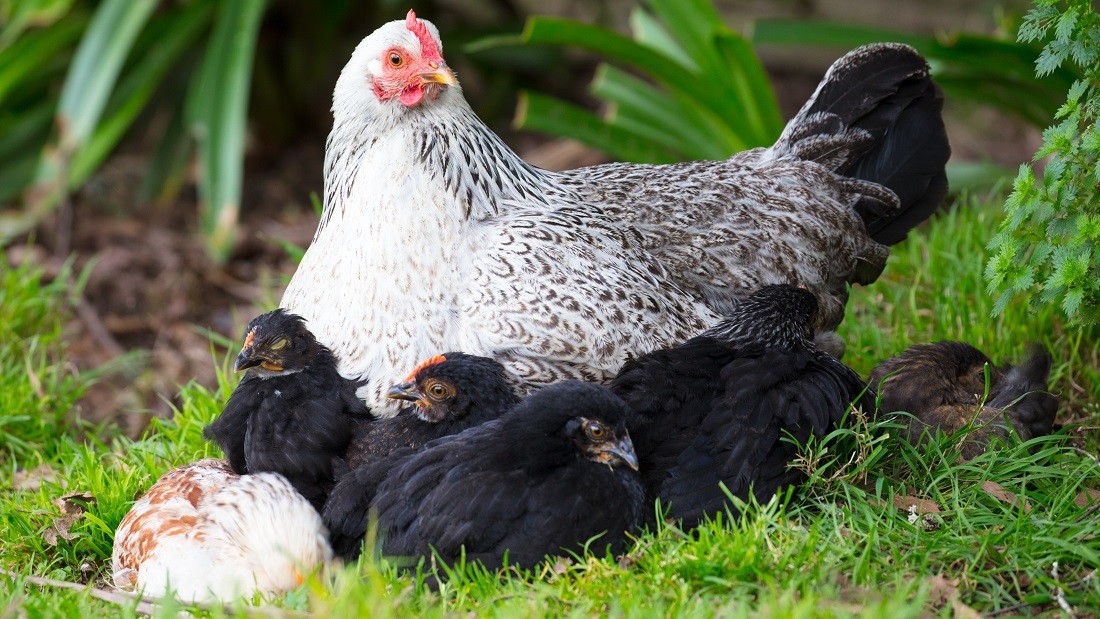
Nesting in the wild
Wild chickens lay approximately between 10 to 15 eggs a year during breeding season, which naturally would fall in spring or early summer.10Collias NE and Collias EC. 1967. A field study of the Red Jungle Fowl in north-central India. The Condor. 69(4):360-8.
To make sure that her eggs are safe, hens will leave the group and find a secluded nest site ready to lay.11Weeks CA and Nicol CJ. 2006. Behavioural needs, priorities and preferences of laying hens. World’s Poultry Science Journal. 62:296-307. Wild fowl favour tall patches of grass or under the roots of a tree to provide cover for their broods. They will often line their nests with vegetation and feathers to keep them warm and dry.12Duncan IJH, Savory CJ, and Wood-Gush DGM. 1978. Observations on the reproductive behaviour of domestic fowl in the wild. Applied Animal Ethology. 4:29-42. 62.
After laying her eggs the hen will sit on them day and night for three weeks. She will leave the nest only once a day to get food and water and dust bathe. The average size of each brood is 4-6 chicks.
Following hatching, chicks spend their early lives in close proximity to, if not under, their mother, especially in the first four days. Hens maintain their brood as a discreet unit away from other individuals in the social group.13Edgar J, Held S, Jones C, Troisi C. Influences of Maternal Care on Chicken Welfare 2016. Animals 2016, 6(1), 2. A hen will call her young to hide under her at any sign of danger and will even put herself in harm’s way to protect her chicks if she needs to.14Rogers LJ. 1995. The Development of Brain and Behaviour in the Chicken. CAB International. 159.15. Wood-Gush DGM, Duncan IJH, and Savory CJ. 1978. Observations on the social behavior of domestic fowl in the wild. Biology of Behaviour. 3(3):193-205.
In a natural situation, chicks would remain with their mothers for 5-12 weeks.
How long do chickens naturally live?
A chicken’s natural lifespan is usually five to eight years and in some cases they can live 10 to 12 years.
Females over a year old are referred to as hens and younger females as pullets. Males over a year old are called roosters whilst younger males are referred to as cockerels.
The egg-laying hen is possibly the most abused animal on earth. Born in a hatchery without ever knowing her mother, she is usually forced to live most of her life with thousands of other birds (often in a crowded shed) laying 20 to 30 times the number of eggs she would naturally.
In the wild, hens lay just 10 to 15 eggs per year, mostly during spring or early summer when food is plentiful and warmer temperatures increase chick survival chances. By contrast, commercially bred hens lay an unnaturally high number of eggs – 300 or more.1The Humane League. 2024. How many eggs does a chicken lay in UK farming? Available at: https://thehumaneleague.org.uk/article/how-many-eggs-does-a-chicken-lay [Accessed 21 August 2025]. This seriously damages their health, often leading to weak or broken bones and exhaustion. This extreme output is achieved through selective breeding and genomics, where the birds’ DNA is analysed to select for high egg production and other profitable traits, along with manipulating the hens’ environment. In the UK, welfare codes prohibit continuous lighting and require hens to have six to eight hours of uninterrupted darkness every day. Nevertheless, producers are permitted to use artificial lighting to extend laying periods, and hens also receive high-protein feed to maximise egg output.
Most hens are pushed to lay at a rate entirely unsustainable for their bodies, resulting in ‘spent hens’ – birds considered unproductive – being sent for slaughter when only about 18 months old. This is a small fraction of their potential natural lifespan.
How many eggs are eaten in the UK?
Despite the cruelty involved in the UK egg industry, people’s appetite for eggs continues to grow year on year, with over 13.6 billion eggs consumed in the UK in 2024.2British Egg Information Service. 2024. UK egg industry data. Available at: https://www.egginfo.co.uk/egg-facts-and-figures/industry-information/data [Accessed 21 August 2025].
How much is the UK egg industry worth?
The UK egg market is worth £1.9 billion and growing year on year.2British Egg Information Service. 2024. UK egg industry data. Available at: https://www.egginfo.co.uk/egg-facts-and-figures/industry-information/data [Accessed 21 August 2025].
The egg market in the UK is dominated by a handful of major egg producers who supply the major supermarkets. Noble Foods is the leading egg producer in Britain and owns several egg brands, including The Happy Egg Co, Purely Organic and Big & Fresh.3Noble Foods. 2025. Egg brands. Available at: https://www.noblefoods.co.uk/egg-brands [Accessed 21 August 2025]. With more than 250 producers around the UK, they pack some 33 million British Lion-approved eggs every week.4Noble Foods. 2025. Noble Foods Modern Slavery Statement – 2024. Available at: https://www.noblefoods.co.uk/wp-content/uploads/2025/02/Modern-Slavery-Statement-Feb-2025.pdf [Accessed 21 August 2025]. Other large producers include Fairburn’s Eggs who supply over 14 million eggs a week 5Fairburn’s Eggs. 2025. Our story. Available at: https://www.fairburnseggs.co.uk/our-story [Accessed 21 August 2025]. and Bird Bros who produce over four million eggs a week.6Bird Bros. 2025. Our history. Available at: https://birdbroseggs.co.uk/our-story [Accessed 21 August 2025].
Standards in the UK egg industry are overseen by a number of assurance certification schemes. The Lion Code of Practice is managed by the British Egg Industry Council and 90 per cent of UK eggs carry the Lion Mark. There are no extra welfare requirements for the Lion Code of Practice for caged hens – in other words, basic legal minimum standards are approved. RSPCA Assured inspects organic, free-range and barn systems, (caged hens are not included) and the Soil Association is for organic eggs. These schemes all follow UK government legislation plus, in some cases, extra requirements depending on the scheme.
There are currently estimated to be 43 million egg-laying hens in the UK – 21 per cent caged, 72 per cent free range (including four per cent organic), and seven per cent barn.2British Egg Information Service. 2024. UK egg industry data. Available at: https://www.egginfo.co.uk/egg-facts-and-figures/industry-information/data [Accessed 21 August 2025].
No matter whether the hen is caged, free range, barn or organic, hens are forced to endure continual suffering from birth to death.
Sterile beginnings
Once eggs are laid, they are transferred to industrialised incubators to develop in tiered racks of trays and hatch at around 21 days. In the wild, mother hens would help their chicks to hatch but on farms, they have to do it alone, using their ‘egg tooth’ to break out of the shell.
Chicks are placed on a conveyor belt and their fate depends on their gender and health. Male chicks, who cannot lay eggs and are unsuitable for meat production, along with weak or sickly female chicks, are usually culled shortly after hatching, often within one day.
Healthy female chicks will receive a prophylactic (preventative) vaccination, in the form of a mist or injection in the back of the neck, to protect them against diseases. They will then be transported to a ‘growing site’ to start their lives as egg layers.
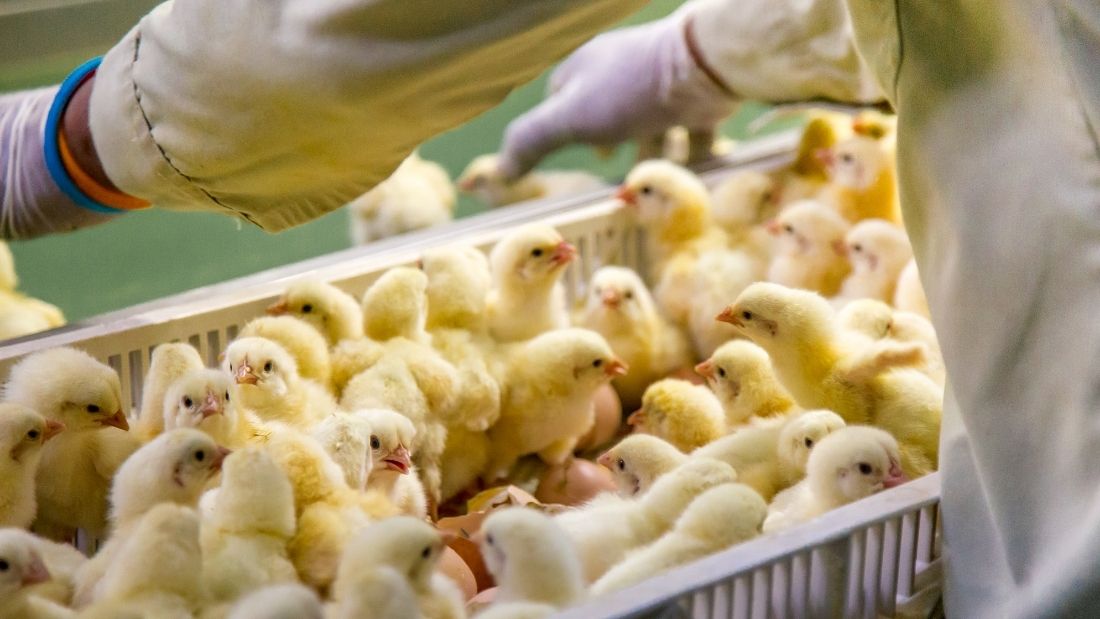
What happens to male chicks in the egg industry?
All male chicks, and weak or sickly females, are killed within 24 hours of birth and disposed of as a by-product of the industry.
It is common practice in all types of commercial egg farming – whether caged, free range, barn or organic – that male chicks are killed within a day of birth.
It is estimated that 40 to 45 million day old chicks are killed in the UK each year by gassing.7Animal Welfare Committee. 2023. Opinion on alternatives to culling newly hatched chicks in the egg and poultry industries. Available at: https://www.gov.wales/sites/default/files/publications/2023-11/awc-opinion-alternatives-culling-newly-hatched-chicks-poultry-industry.pdf [Accessed 21 August 2025].[Accessed 13 May 2020]
Other countries also macerate chicks (they are ground up by rollers or minced with fast moving blades). A grizzly end to their innocent, new lives.
Why are male chicks killed?
In commercial chicken farming, broiler (meat) chickens are selectively bred to reach adult weight in just six weeks. They are large-breasted and legged and develop very quickly for maximum productivity.
Egg-laying chickens, on the other hand, are bred to be as lean as possible to save space and to channel all their energy into laying eggs. A male chicken of the egg-laying breed is therefore useless to the industry as he cannot lay eggs and cannot grow quickly enough to produce quality commercial meat.8RSPCA Assured. 2025. What is chick maceration? Available at: https://www.rspcaassured.org.uk/farmed-animal-welfare/egg-laying-hens/what-is-chick-maceration [Accessed 21 August 2025].
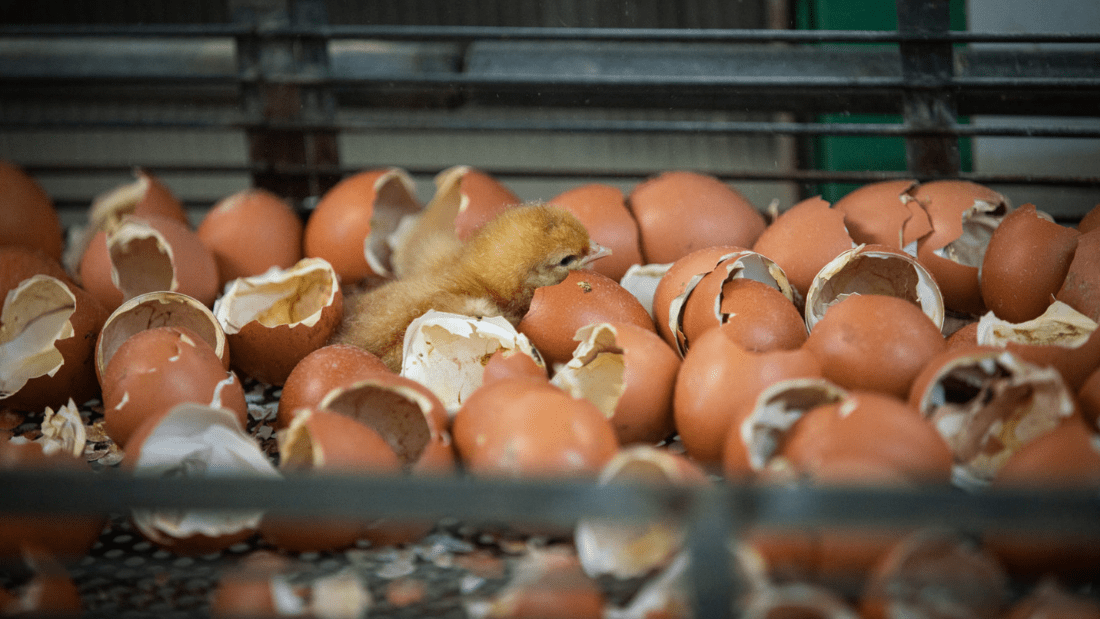
Photo: Andrew Skowron
The fate of the females
Female chicks that survive the initial sorting and culling process are transported, often at just one day old, to ‘growing sites’ where they will be raised to become egg-laying hens.
Transport for these day-old chicks can be traumatic. Chicks are shipped in large numbers, often over long distances in disposable cartons or crates. Young chicks are sensitive to temperature, and they can experience heat or cold stress during transport because they cannot regulate their body temperature well at this age. They are denied food and water for the duration of the journey, which can last for up to 36 hours, and are expected to rely on yolk sac reserves which may last for up to 72 hours after hatching.9van der Wagt I, de Jong IC, Mitchell MA et al. 2020. A review on yolk sac utilization in poultry. Poultry Science. 99 (4) 2162-2175.
Mother hens play a crucial role in teaching their chicks how to behave, what to peck and how to cope with threats. Research shows that female chicks raised without their mother and forced to grow up among other, unrelated females are more fearful and prone to behaviours like feather pecking. Without maternal care, chicks experience higher stress and behavioural issues linked to crowded, unstimulating environments lacking natural social structure.10Edgar J, Held S, Jones C et al. 2016. Influences of maternal care on chicken welfare. Animals (Basel). 6 (1) 2.
At growing sites, young pullets (female chickens) often remain indoors and may not have access to the outdoors for up to 18 weeks. Pullets raised for caged systems typically never experience outdoor conditions – they will never see the sky, feel fresh air or walk on soil. By 16 to 20 weeks old, pullets are mature enough to start laying eggs and are then transported to laying farms or moved to a different shed on the same site to begin egg production. Those destined for free range or organic farms will be transferred to environments where they may go outside for some of the time.
Laying hens have been selectively bred for a very high production of eggs. Modern commercial hens produce around 300 eggs a year, 20 to 30 times more than they would in the wild. However, some egg companies are now pushing hens to lay over 500 eggs in 100 weeks – just under two years.11Hendrix Genetix. 2020. Achieving 500 Eggs in 100 Weeks in Free Range conditions in the United Kingdom. Available at: https://layinghens.hendrix-genetics.com/en/news/achieving-500-eggs-100-weeks-free-range-conditions-united-kingdom [Accessed 21 August 2025].
When do chickens stop laying eggs?
Hens that are no longer deemed productive are called ‘spent hens’ and whether conventionally farmed or organic, are usually slaughtered and used for lower-quality products since their bodies are worn out from intensive egg laying. This culling typically occurs at around 18 months (around 72 weeks) of age.
Housing
The overwhelming majority of egg laying hens in the UK, whether caged, free range or barn, spend much of their lives indoors in large industrial units.
There are four ways chickens bred for egg production are housed in the UK. A producer code is used on eggs to identify and trace them. It includes a digit to show the farming method:
- 3 for caged
- 2 for barn
- 1 for free range
- 0 for organic
It also has a code to show the country of origin (eg UK) and a unique identification number for the premises the eggs were produced on.

Caged eggs
Caged hens currently make up 21 per cent of the UK market.2British Egg Information Service. 2024. UK egg industry data. Available at: https://www.egginfo.co.uk/egg-facts-and-figures/industry-information/data [Accessed 21 August 2025].
Caged hens are the only major group of farmed animals in the UK to remain caged for all of their productive lives. Unable to escape the close proximity of other hens or fulfil natural behaviours, life in enriched cages, is one of boredom, desperation, frustration and suffering.
Barren battery cages were made illegal in the UK in 2012. These prison-like cages provided hens with approximately 550 cm2 of space – less than the area of an A4 sheet of paper. A hen’s average wingspan is about four times this size and so she would spend the vast majority of her life unable to even spread her wings. Sadly, the majority of the rest of the world’s egg laying hens are still kept in battery cages.
Enriched cages
When they were banned, barren battery cages in the UK were replaced with ‘enriched’ or colony cages which require the provision of limited facilities for perching, nesting and scratching.
Under UK regulations, there is no specific legal limit on the number of hens that can be kept in a single enriched cage. Instead, the law mandates a minimum space requirement per hen of 750 cm² of cage area, with 600 cm² of usable space.12Defra. 2024. Code of practice for the welfare of laying hens and pullets. Available at: https://www.gov.uk/government/publications/poultry-on-farm-welfare/poultry-welfare-recommendations [Accessed 21 August 2025]. This gives hens no more than a postcard size of extra space compared to battery cages.
Each wire cage may typically house 40 to 80 hens and there is no limit on how high the cage tiers can be stacked. In many farms, although caged hens technically have access to enrichments, it doesn’t mean that they’re able to use them – if aggressive territorial hens are guarding enrichments, others many may never get access.
Birds in enriched cages will spend a significant proportion of their time standing on sloping wire mesh floors with little room to move around or stretch their wings. They live under controlled artificial lighting – denied fresh air and sunshine. When their eggs are laid, they roll out of reach of the birds onto a conveyor belt to await collection.

Enriched cages do not satisfy even the hen’s most basic behavioural and physical needs such as ground scratching and wing stretching, or activities such as walking, running, jumping, fluttering and flying. In short, there is no meaningful ‘enrichment’ in the enriched cage.
Viva! has carried out multiple high profile investigations into caged hens in the UK and found injured, dead and dying birds with severe feather loss and without adequate nesting boxes.
Read more about our Cracked campaign here.
For these reasons, all of the major animal welfare organisations in Europe continue to push for a complete ban on cages – battery and enriched. Enriched cages are already banned by law in several European countries, including Austria, Switzerland and Luxembourg, where no commercial hens are kept in cages. Germany has banned new enriched cages from 2025, with existing systems allowed to operate until the end of 2025 (2028 in hardship cases), aiming for complete cage-free production by 2029. The Czech Republic has legislated to phase out all cages by 2027, while Slovakia plans to phase out enriched cages by 2030. France has banned building new cage systems and is actively transitioning existing flocks to cage-free systems. Outside Europe, countries such as Bhutan have banned battery cages and others such as India and New Zealand have phased out battery cages with ongoing moves away from enriched cages.
Most major UK supermarkets have already stopped selling caged eggs or committed to stopping selling them by the end of 2025. However, Asda appears to be lagging, and Iceland has officially delayed its commitment to 2027.13Iceland. 2025. Iceland foods reinstates cage-free egg commitment with new 2027 timetable. Available at: https://sustainability.iceland.co.uk/news/iceland-foods-reinstates-cage-free-egg-commitment-with-new-2027-timetable [Accessed 21 August 2025].[Accessed 21 August 2025].
Barn eggs

Around seven per cent of eggs sold in the UK are intensively produced ‘barn eggs’.2British Egg Information Service. 2024. UK egg industry data. Available at: https://www.egginfo.co.uk/egg-facts-and-figures/industry-information/data [Accessed 21 August 2025].
While this term conjures up the image of a rustic hen house with a few dozen hens sitting peacefully on their own nests, the truth is somewhat different.
Barn systems are permitted to house up to nine hens per square metre of useable area (16.5 hens per square metre of floor area) and including the ground, may include up to four levels for the hens. Perches must be provided allowing 15 centimetres of perch per hen. Litter for scratching and dust bathing must account for one third of the ground surface. Either one nest box per five hens or communal nests, at the rate of 120 birds per quare metre of floor area, must also be provided – leading to the same problem of competition for space as in enriched cages.
The British Lion standard limits the number of birds in each perchery to 6,000 and stipulates, with at least two enrichments per 1,000 birds.14British Egg Information Service. 2025. Barn egg production. Available at: https://www.egginfo.co.uk/egg-facts-and-figures/production/barn-egg [Accessed 21 August 2025]. They live their whole lives under artificial lighting with very little space and very little to do.
Free-range
Currently, 72 per cent of egg-laying hens in the UK are considered free range, including four per cent organic.2British Egg Information Service. 2024. UK egg industry data. Available at: https://www.egginfo.co.uk/egg-facts-and-figures/industry-information/data [Accessed 21 August 2025].
The free range egg market has been steadily growing over recent decades and has now overtaken the volume of caged and barn eggs sold in the UK. An increasing appetite for what consumers perceive as ‘more ethical’ eggs, coupled with a decrease in the price difference, mean that free range is now the most popular consumer choice.
Are free-range eggs better?
Sadly, ‘free range’ means very little in terms of animal welfare. Many free range hens spend most of their lives in vast, stinking, overcrowded sheds, just as hens housed in barns do. Whilst free range may make you think of happy hens living outdoors, the reality can be tens of thousands of birds in one shed!
Chickens producing free range eggs live much the same life as barn chickens. They are housed indoors in a perchery, which has the same requirements as barn chickens (see above).

How are free-range eggs different from barn eggs?
There is one key difference – eggs sold as free-range must* come from hens who have access to the outdoors.
Under the Lion Quality Code of Practice, free range hens are required to have access to runs which are mainly covered with vegetation for at least eight hours a day through ‘pop-holes’, with one pop-hole provided for every 600 birds. The outdoor area must offer shade and shelter, and stocking density cannot exceed 2,000 hens per hectare (about one hen per five square metres). Large flocks are capped at 16,000 birds and flocks over 6,000 hens must be divided into smaller groups of no more than 4,000 hens each.15British Egg Information Service. 2025. Free range egg production. Available at: https://www.egginfo.co.uk/egg-facts-and-figures/production/free-range-egg [Accessed 21 August 2025].
This should, in theory, allow all to leave the shed. However, scientific studies have shown that in large free range flocks, only a small percentage of hens actually go outside. Hens can be fiercely territorial and will guard these exit holes. The sheer number of birds in a shed, coupled with dominant guarding of pop holes, means that a significant percentage of hens never go outside.16Chielo LI, Pike T and Cooper J. 2016. Ranging behaviour of commercial free-range laying hens. Animals (Basel). 6 (5) 28. One study revealed that, on average, only nine per cent of hens went outside at any given time and many never went outside at all.17Hegelund L, Sørensen JT, Kjær JB et al. 2005. Use of the range area in organic egg production systems: effect of climatic factors, flock size, age and artificial cover. British Poultry Science. 46, 1-8.
Viva!’s investigations into several free range and barn egg farms have exposed crowded conditions and poor environmental enrichment. For example, Viva!’s 2025 investigation into free range egg farms supplying major brands revealed thousands of birds in industrial scale sheds, packed with solid excrement and many birds never ventured outside. Whilst previously, Viva! uncovered shocking overcrowded conditions – some birds with extensive feather loss, dead birds and one with a presumed prolapse and a severely injured hen unable to walk.
* As of January 2025, UK law now allows eggs to be labelled ‘free range’ indefinitely during a compulsory poultry housing order, meaning that if birds must be kept indoors for months due to national bird flu restrictions, their eggs can still be sold as ‘free range’ even if the hens never go outdoors. See more here.
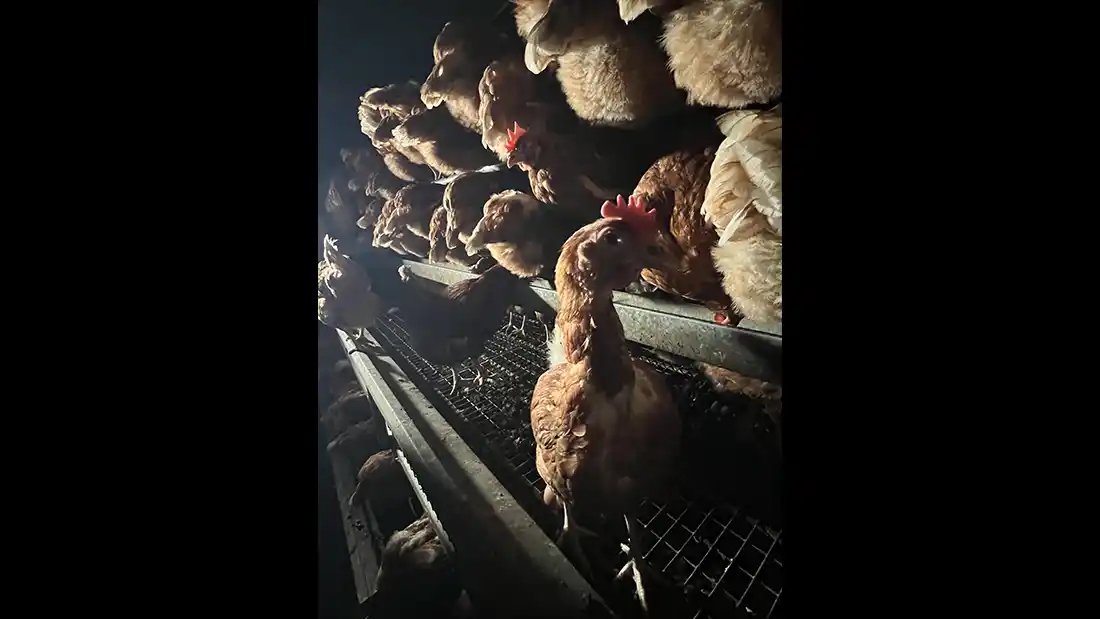
Organic
Organic eggs make up just four per cent of the UK egg market2British Egg Information Service. 2024. UK egg industry data. Available at: https://www.egginfo.co.uk/egg-facts-and-figures/industry-information/data [Accessed 21 August 2025]. and conjure up an image of a handful of happy chickens pecking away in a farmyard orchard but is that really the true picture?
To be sold as organic in the UK, eggs must come from a farm that has been approved by a certification body. However, there are different organisations and not all have the same standards as to what makes a farm ‘organic’.
Are organic eggs more ethical?
Organic farms, like free range and barn farms, have come under fire for housing animals in cramped conditions. Hi-tech multi-tier aviary systems, where conveyor belts below the tiers remove the manure at regular intervals, are becoming more common in organic egg production.18Farmers Weekly. 2008. Organic egg producer chooses multi-tier system. Available at: https://www.fwi.co.uk/news/farm-policy/organic-egg-producer-chooses-muilti-tier-system Accessed 21 August 2025]. So, not quite the idyllic farmyard set up you might have imagined.
Hens producing organic eggs are always free range, but must also be fed an organically produced diet and range on organic land. National standards set by the EU Organic Regulations stipulate a maximum stocking density of six hens per square metre of useable area and a maximum flock size of 3,000 birds. Hens must be provided with nest boxes and perches providing 18cm of perch space per hen (3cm more than barn hens). Litter for scratching and dust bathing must be provided, accounting for one-third of the ground surface.
British Lion organic eggs include the provision of outdoor shading, additional height and width of pop-holes, open for eight hours daily to allow access to the outside; and a maximum range area stocking density of up to 2,000 birds per hectare.19British Egg Information Service. 2025. Organic egg production. Available at: https://www.egginfo.co.uk/egg-facts-and-figures/production/organic-egg [Accessed 21 August 2025].
Under Soil Association standards, each hen is allowed a minimum of 10 square metres of space outside, compared to four square metres for hens reared to EU organic standards. Certified farmers must also give hens access to the outdoors at 12 weeks – a much younger age than in free range systems. Beak trimming is banned under Soil Association’s organic standards as is the routine (preventative) use of antibiotics.20Soil Association. 2025. Organic eggs. Available at: https://www.soilassociation.org/take-action/organic-living/what-is-organic/organic-eggs [Accessed 21 August 2025].
Hens on Soil Association certified farms are then less likely to be injured or killed by other hens. However, the Soil Association’s standards are difficult to apply on farms large enough to supply major supermarkets so people may have difficulty finding these eggs.
Of course, day old male chicks and spent hens are still slaughtered in organic systems.
Injuries, disease and mutilations
Feather pecking, cannibalism and debeaking
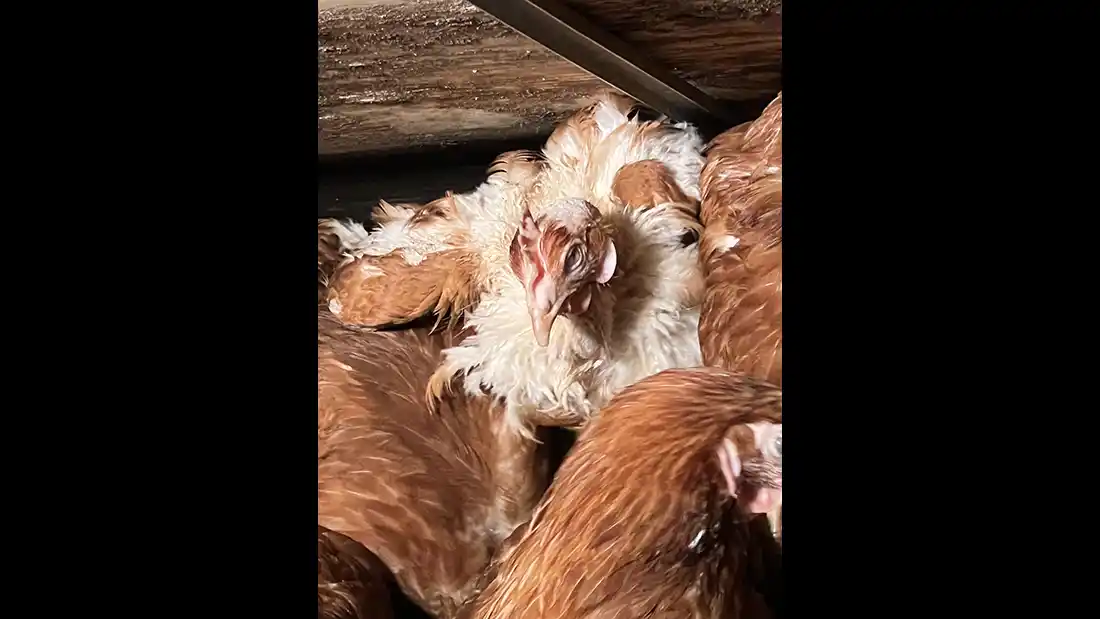
Being squashed into wire mesh cages frustrates these naturally active birds and boredom, coupled with lack of space, means a ‘pecking order’ is replaced by injurious feather pecking (IFP).
Feather pecking can commence when chicks are just a few weeks old and then develop into IFP. It can also spread rapidly within a flock as a learned behaviour. Feather pecking leads to increasingly exposed patches of skin, which become red and sore. A visibly open wound or blood can then drive hens to cannibalism.
‘Aggressive pecking’ is directed at the head of another bird and ‘feather pecking’ is directed at the plumage. Hens will often rip out the feathers of other hens or even peck them to death and engage in cannibalism. When hens injure and kill one another in this way, it damages the producer’s profit margin so it is in the interests of the egg industry to minimise these injuries.
Hens kept in cage systems are, therefore, routinely debeaked to prevent injury from aggressive cage-mates – a problem caused by the intensive conditions in which they are forced to live.

The debeaking procedure (known as beak trimming in the poultry industry) involves the partial removal of the tip of a hen’s beak, a process which is performed without anaesthesia. Whilst in the past this was done with a red hot blade, causing the hen intense pain, it is now carried out with an infra-red beam whilst the chick is still in the hatchery.21British Hen Welfare Trust. 2025. 2020. Beak trimming – mutilation or a necessity? Available at: https://www.bhwt.org.uk/beak-trimming/ [Accessed 21 August 2025].Debeaking is done to all egg-laying chicks whether caged, barn or free range, the only exception being organic, where beak trimming is prohibited.
Despite being promoted as less painful and traumatic than hot blade trimming, studies have shown that this method still causes pain. A chicken’s beak is highly sensitive, rich in blood vessels and nerve endings. The process can lead to inactivity and loss of appetite due to the pain.22Marchant-Forde RM, Fahey AG and Cheng HW. 2008. Comparative effects of infrared and one-third hot-blade trimming on beak topography, behavior, and growth. Poultry Science. 87, 1474-1483. The Farm Animal Welfare Committee (FAWC) – now succeeded by the Animal Welfare Committee (AWC) – refers to all beak trimming as a ‘mutilation’ and describes the practice as a “major welfare insult”.23Farm Animal Welfare Council. 2007. Opinion on beak trimming of laying hens. Available at: https://assets.publishing.service.gov.uk/media/5a7cfb3eed915d28e9f3954e/FAWC_opinion_on_beak_trimming_of_laying_hens.pdf [Accessed 21 August 2025].
Due to the substantial body of evidence against the inhumane practice of beak trimming, a ban has been discussed in the UK for years. Debeaking isn’t used, or has been prohibited, in several European countries, such as Germany, Norway, Finland, Sweden, Austria and Denmark – all of which use higher welfare methods to reduce stress, and therefore pecking, amongst the birds. A UK ban has been postponed multiple times, following advice from Farm Animal Welfare Council, until it can be demonstrated under commercial conditions that laying hens could be managed without beak trimming.
The main reason for stereotypical and aggressive behaviour in laying hens is squarely down to the unnatural way they are kept, which – even in higher welfare cases – does not truly reflect their natural state nor allow them to express all natural behaviours.
Sanctuaries which offer hens a genuinely free range life in small flocks find that birds do not feather pick and have healthy, shining feathers.
Injuries
Hens kept in cages or crowded barns have barely enough space to move around and so have little chance to exercise. This, combined with the loss of calcium due to the hundreds of eggshells a hen has to produce in her lifetime, produces a high rate of osteoporosis and broken bones. Osteoporosis and consequent bone fracture are rare in wild birds.24Farm Animal Welfare Council. 2010. Opinion on osteoporosis and bone fractures in laying hens. Available at: https://assets.publishing.service.gov.uk/media/5a7d8dc2ed915d497af7022e/FAWC_opinion_on_osteoporosis_and_bone_fractures_in_laying_hens.pdf [Accessed 26 August 2025].
Keel bone (sternum or breastbone) fractures in hens are one of the major welfare concerns for farmed hens. Not only do they cause them pain for weeks at a time, but a fracture can limit their movement, making it difficult for them to get up to perches or protect themselves from aggressive pecking. Laying hens reach full body size by 16 to 18 weeks, but their keel bone keeps hardening until around 40 weeks. When they begin laying, part of the keel is still soft cartilage and may not get enough calcium to harden properly because so much calcium is used for making eggs.25Riber AB, Casey-Trott TM and Herskin MS. 2018. The influence of keel bone damage on welfare of laying hens. Frontiers in Veterinary Science. 5, 6.
Standing on wire mesh for the entirety of their lives, hens often develop sores on their legs and feet. Also red and sore featherless patches on the breast and under the legs can develop into sores when exposed to ammonia from urine.

Diseases
High-density sheds, whether caged or free range, provide ideal conditions for disease to spread. Because of this, prophylactic (preventative) antibiotics were commonly used in caged, barn and some free-range chickens. However, concerns over antibiotic resistance have led to increased efforts to limit routine antibiotic use in animal agriculture.
In May 2024, UK law changed to restrict prophylactic use of farm antibiotics to “exceptional circumstances” where the risk of infection or infectious disease is “very high”.26The National Archives. 2024. The Veterinary Medicines (Amendment etc.) Regulations 2024. Available at: https://www.legislation.gov.uk/ukdsi/2024/9780348258523 [Accessed 26 August 2025]. While this may be considered a step forward, the UK rules are less strict than EU regulations introduced in January 2022, which ban prophylactic group antibiotic treatments altogether and restrict prophylaxis to individual animals only. Critics warn that because intensive farming often involves a high risk of infection, prophylactic antibiotic use in large groups of animals may still continue frequently under the UK law.27Alliance to Save Our Antibiotics. 2024. New law banning routine use of farm antibiotics flawed by major weaknesses and loopholes. Available at: https://www.saveourantibiotics.org/news/press-release/new-law-banning-routine-use-of-farm-antibiotics-flawed-by-major-weaknesses-and-loopholes [Accessed 26 August 2025]. The only exception is in organic farming where the use of preventative antibiotics is not permitted.
Respiratory diseases are common in chickens and spread rapidly in high-density conditions. Infectious bronchitis (IB) is highly contagious; it typically infects 100 per cent of birds in a flock once introduced. Mortality from IB is usually around five per cent but can reach as high as 60 per cent when complicated by secondary bacterial infections or virulent strains.28Jordan B. 2025. Infectious bronchitis in chickens. MSD Manual, Veterinary Manual. Available at: https://www.msdvetmanual.com/poultry/infectious-bronchitis/infectious-bronchitis-in-chickens [Accessed 26 August 2025]. Infectious bursal disease is also a common viral disease affecting chickens. The spread and impact of IB are exacerbated by close housing and dense populations.
A major and distressing cause of death in layers is egg peritonitis – infection and inflammation in the abdominal cavity. It can be caused by E. coli infection of the laying duct and if hens are unable to expel an egg, it may cause infection leading to peritonitis, especially if the egg breaks internally, providing a rich medium for bacterial growth. Prolapses may also occur, where part of the laying duct protrudes from the hen. Hens naturally peck at anything unusual and the result is that pecking from other birds can turn the prolapse into a painful, bloody infected wound.
Skin diseases are also common, some as a result of prolonged contact with moist, filthy litter, causing ammonia burns and blisters.
Red mite (Dermanyssus gallinae) infestations are a common and serious problem in poultry, especially in laying hens. These blood-sucking parasites cause extreme skin irritation, which increases stress and feather pecking. Heavy infestations can lead to anaemia, weight loss and death. Younger birds and chicks are more severely affected. Beak trimming worsens the problem because hens cannot properly groom to remove mites. Red mites also contribute to disease transmission, further impacting bird health.29Balfour M. 2022. Red mite: Implications and control strategies. St David’s Poultry Team. Available at: https://www.stdavids-poultryteam.co.uk/news/red-mite-implications-and-control-strategies/ [Accessed 26 August 2025].
Among caged birds, welfare and disease problems of all kinds are exacerbated by difficulty in inspecting birds – cages are stacked in tiers and the top and bottom layers may be both poorly lit and difficult for stock keepers to reach and see.
Avian flu
Some diseases in chickens and other poultry can also infect mammals, including humans, sometimes with fatal consequences.
Avian influenza, or bird flu, is highly contagious and can spread between wild birds and farmed poultry and back again. The disease spreads rapidly in crowded factory farm sheds and when it is detected in farmed flocks, all birds are usually killed and a restricted zone is established to limit movement of animals and contain the outbreak.
The current global wave of the highly pathogenic strain H5N1 is ongoing. This virus was first identified in farmed geese in Guangdong, China in 1996 and has caused outbreaks ever since. A highly aggressive variant emerged in 2020, killing vast numbers of wild birds and poultry across Africa, Asia and Europe, before spreading to North America in 2021 and Central and South America in 2022.30Wan XF. 2012. Lessons from emergence of A/goose/Guangdong/1996-like H5N1 highly pathogenic avian influenza viruses and recent influenza surveillance efforts in southern China. Zoonoses Public Health. 59, Suppl 2, 32-42.
H5N1 is no longer confined to birds. It has been found in mammals including foxes, bears, seals, cats, dogs and animals confined in zoos such as tigers and leopards. Farmed animals such as mink, goats and most recently cows, have also been infected. Since 2024, the virus has spread to hundreds of US dairy herds across more than a dozen states, raising major concerns about animal agriculture as a viral reservoir.
When humans become infected, illness is often extremely severe and frequently fatal. Most cases have involved close contact with infected birds, other animals or contaminated environments. So far, the virus does not spread easily between people. However, scientists warn that just a handful of mutations could make H5N1 highly transmissible in humans – a scenario that could trigger a catastrophic influenza pandemic.31Lin TH, Zhu X, Wang S et al. 2024. A single mutation in bovine influenza H5N1 hemagglutinin switches specificity to human receptors. Science. 386 (6726) 1128-1134.
Can you catch bird flu from chickens?
Like most viruses, avian flu mutates constantly. Several strains have crossed into humans, including H5N1, H7N9, and H5N6.32NHS. 2022. Bird flu. Available at: https://www.nhs.uk/conditions/bird-flu [Accessed 26 August 2025]. H5N8 has infected people only rarely, with generally mild outcomes, but H5N1 in particular carries one of the highest fatality rates of any known flu strain. According to the World Health Organisation, since 2003 there have been 964 confirmed human cases of H5N1 and 466 deaths, most linked to direct handling of infected birds.33World Health Organisation. 2025. Available at: cumulative-number-of-confirmed-human-cases-for-avian-influenza-a(h5n1)-reported-to-who–2003-2025.pdf [Accessed 26 August 2025].
The crowded and stressful conditions of factory farms act as breeding grounds for influenza viruses, enabling rapid spread, mixing and evolution. Every new outbreak increases the chance of genetic changes that might one day enable sustained human to human transmission.
A global threat that demands change
H5N1 continues to spread widely in wildlife, farmed poultry and now other farmed animals. The longer this cycle continues, the higher the risk for humans. Scientists warn that ignoring this crisis is dangerously shortsighted.34Wallace RG. 2009. Breeding influenza: the political virology of offshore farming. Antipode. 41 (5) 916-951.
Preventing the next pandemic is not just about vaccines and surveillance – it requires tackling the root cause: our exploitation of animals in industrial farming.
Do eggs still have salmonella?
Salmonella is a bacterium found in wild animals and the environment that can easily enter the food chain. It is a leading cause of foodborne illness in the UK and can lead to severe illness and may even prove fatal. Between 2015 and 2020, Salmonella caused 27 per cent of all foodborne outbreaks, with eggs implicated in 26 per cent of these, making them a major source of infection.35Food Standards Agency. 2023. Salmonella risk profile of UK-produced hen shell eggs: Hazard identification. Available at: https://www.food.gov.uk/research/salmonella-risk-profile-of-uk-produced-hen-shell-eggs-hazard-identification [Accessed 26 August 2025].
Following a major Salmonella outbreak in eggs in the 1990s, the UK introduced a vaccination programme for laying hens starting in 1998. This, together with improved biosecurity and hygiene, led to a decline in human Salmonella cases linked to eggs. Today, around 85 per cent of UK laying hens are vaccinated against Salmonella and vaccination is mandatory for eggs certified under the Lion Quality assurance scheme.
Despite this, occasional infections still occur; for example, in 2024, Salmonella infections in the UK reached a decade high, with a 17.1 per cent increase from 2023, rising from 8,872 cases in 2023 to 10,388 cases in 2024. Children under 10 years old were particularly affected, accounting for 21.5 per cent of cases.36UK Health Security Agency (UKHSA). 2025. Cases of Salmonella and Campylobacter highest in a decade. Available at: https://www.gov.uk/government/news/cases-of-salmonella-and-campylobacter-highest-in-a-decade [Accessed 26 August 2025].
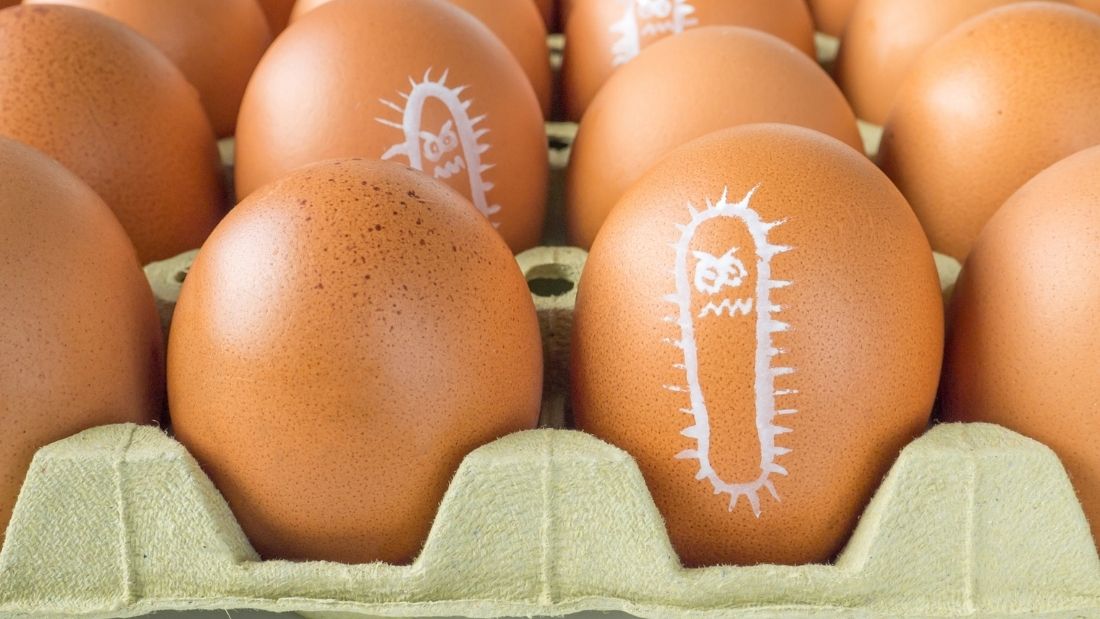
Most egg-laying hens live short and miserable lives. Their optimum laying capacity is reached by the time they are one to two years old and most are considered ‘spent’ at around 18 months (around 72 weeks) of age.
As with broiler (meat) chickens, spent hens are sent to slaughterhouses where several thousand birds can be killed every hour in a factory-like, high speed operation.
In 2024, around 25 million spent egg-laying hens were killed in the UK.1UK Food Standards Agency. 2025. Response to Viva! Freedom of Information Request 00033, January 17, 2025. The vast majority (99.6 per cent) of them were slaughtered by gas stun methods, using CO₂ or other gas mixtures. The remaining 0.4 per cent were killed using Halal non-stun methods.2Food Standards Agency. 2024. Results of the 2024 FSA Slaughter Sector Survey in England and Wales. Available at: https://www.gov.uk/government/publications/farm-animals-slaughter-sector-survey-2024 [Accessed 26 August 2025].
Killing spent hens by gas is an approved method in the UK under the Welfare of Animals (Slaughter or Killing) Regulations. It involves placing birds in a chamber that is then flooded with a mixture of gases, typically including CO₂, which causes suffocation due to lack of oxygen usually in less than 2.5 minutes. As with pigs, exposure to CO₂ at high concentrations is considered a serious welfare concern because it is highly aversive. Birds react with vocalisations, severe headshaking, heavy breathing, escape attempts and severe wing flapping making it clear that they are experiencing pain, fear and respiratory distress.3EFSA Panel on Animal Health and Welfare (AHAW); Nielsen SS, Alvarez J, Bicout DJ et al. 2019. Slaughter of animals: poultry. EFSA Journal. 17 (11) e05849. [Accessed 26 August 2025].
- Find out more about chicken gassing in the UK
To be sold as Halal, animals must be alive when their throats are cut and therefore stunning is prohibited. The process used involves the painful and distressing shackling of hens upside-down by their legs. They are then passed through an electric water bath to be stunned before they are killed by a cut to the throat.
There are numerous concerns including how some birds may miss the stunner or receive painful pre-stun shocks. There may be insufficient electrical current passing through the bird’s body to guarantee unconsciousness. Additionally, birds might receive only a single neck cut, reducing blood loss, or accidentally miss the automatic neck cutter altogether and end up entering a scalding tank while still alive.
As said, 0.4 per cent of spent hens are killed using non-stun methods in the UK but that still meant that in 2024, around 100,000 hens may had their throats cut while fully conscious.
What happens to hen meat?
Meat from egg laying hens is deemed as inferior ‘quality’ and in 2019 around 41 per cent went to wholesale traders, mainly for use as pet food. Some 56 per cent was frozen and exported to EU and non-EU countries, one per cent was sent to butchers leaving two per cent unaccounted for.4Defra. 2019. Results of the 2018 FSA survey into slaughter methods in England and Wales. Available at: https://assets.publishing.service.gov.uk/government/uploads/system/uploads/attachment_data/file/778588/slaughter-method-survey-2018.pdf [Accessed 26 August 2025].
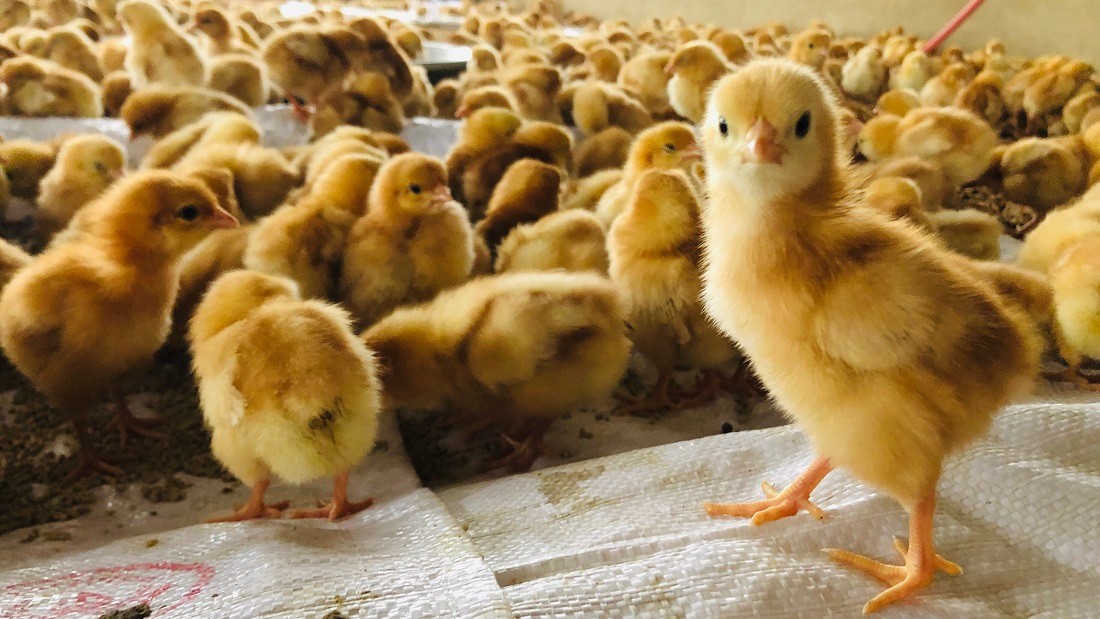
How are male chicks killed?
In the egg industry, all male chicks are routinely killed within a day of hatching because they cannot lay eggs and do not grow efficiently for meat, making them economically unviable to raise. Egg-laying chickens are a different breed from broiler (meat) chickens, which are bred to grow large breast muscle and legs within just six weeks.
It is estimated that 40 to 45 million male chicks are killed every year in the UK, along with weak or sickly females.5Animal Welfare Committee. 2023. Opinion on alternatives to culling newly hatched chicks in the egg and poultry industries. Available at: https://www.gov.wales/sites/default/files/publications/2023-11/awc-opinion-alternatives-culling-newly-hatched-chicks-poultry-industry.pdf [Accessed 21 August 2025]. Chicks bodies are often used as food for the pet industry and zoos – mostly for reptiles and birds of prey.5Animal Welfare Committee. 2023. Opinion on alternatives to culling newly hatched chicks in the egg and poultry industries. Available at: https://www.gov.wales/sites/default/files/publications/2023-11/awc-opinion-alternatives-culling-newly-hatched-chicks-poultry-industry.pdf [Accessed 21 August 2025].
In the UK, nearly all male chicks are killed using an oxygen depleted chamber filled with the inert gas argon. It is recommended that the oxygen level inside the chamber should be less than two per cent because “even five per cent residual oxygen will result in prolonged deaths and the survival of some chicks”.5Animal Welfare Committee. 2023. Opinion on alternatives to culling newly hatched chicks in the egg and poultry industries. Available at: https://www.gov.wales/sites/default/files/publications/2023-11/awc-opinion-alternatives-culling-newly-hatched-chicks-poultry-industry.pdf [Accessed 21 August 2025].
In contrast, most spent hens – egg laying hens who are killed when their egg production falls – are killed with CO₂, a method that causes pain and distress but is preferred to argon for being cheaper, widely available and efficient for large-scale use.
Depending on the combination of gasses used, it can take two or three minutes for chicks to lose consciousness and die.
Maceration, which involves chicks being ground up by a large fast-moving grinder, was used in the past in the UK, and is still used in much of the world, including the US and Australia, where it is considered the ‘more humane’ option. Maceration is still permitted in the UK although the industry claims it is no longer used.
There have been concerted efforts in recent years to phase out the need for mass ‘culling’ of male chicks.
In 2018, scientists in Germany developed a non-invasive method to identify the sex of chicken embryos around seven days after fertilisation. The company Seleggt’s technique, which extracts a small amount of fluid from the egg to detect sex-specific markers, allows male embryos to be identified and separated before hatching to be used in animal feed or processed into other products. Since 2019, so-called ‘no-kill’ eggs have been sold under the Respeggt brand, boasting over 97 per cent accuracy and ending the routine slaughter of male chicks.
Routine male chick culling has been banned in France, Germany and Austria since 2022. Italy, Belgium and the Netherlands are also currently phasing it out and are firmly on track to ban it in the coming years.
In the UK, new technology is beginning to be introduced with support from the Animal Welfare Committee and consumers, but full industry-wide adoption is still progressing slowly.






